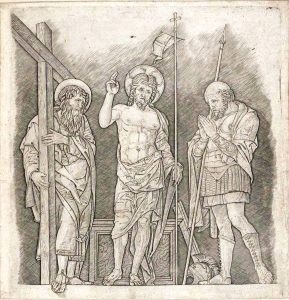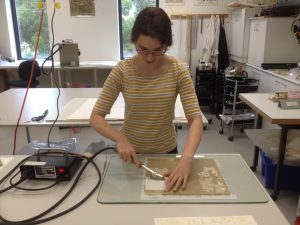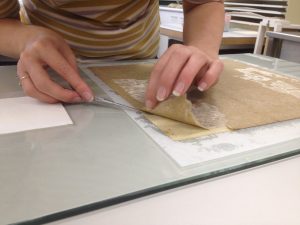Treatment of “The Risen Christ with St Andrew and St Longinus”: An Andrea Mantegna engraving
As part of the Miegunyah bequest funding, engravings after Andrea Mantegna (1431-1506) – much sought after by students of Renaissance art – were conserved. Adele Barbara explains her treatment of one these important works of art.

Initially, it was thought there was only one thick backing layer on the engraving of The Risen Christ with St Andrew and St Longinus that had to be removed. Mechanically removing this backing with a scalpel, however, uncovered another, very thin lining that had been fully adhered to the back of the work. A series of investigations were conducted in order to determine what exactly was bonding this lining to the print and the best way of removing it safely.
To discover what kind of adhesive was used to bind the lining to the back of the work, a series of spot tests were conducted. Spot testing in conservation not only helps to identify materials, but can contribute to the development of a treatment methodology. For this work, both a potassium iodide test and a biuret test was used to assess what kind of adhesive was used. Results indicated that the adhesive was starch based. This series of spot tests helped to troubleshoot the next stage of treatment; the separation of the print from its lining.
In order to separate these layers without disrupting or damaging the print, the starch-based adhesive had to gradually softened. To achieve this, the work was gently humidified before it was carefully placed faced up on a piece of thick, wet blotter. To ensure good contact between the back of the work and the blotter, a sheet of Bondina tissue was placed on top of the work, followed by a sheet of glass. This sandwich of blotter and Bondina allowed moisture to gradually permeate through the layers without causing visual or dimensional change to the print.

After four hours, the work was removed from beneath the glass and hand tools were used to gradually peel back the lining. Some areas of the lining, however, needed a little more encouragement. To help ease the two layers apart, a heated spatula was applied to the work with a wet blotter to further soften the adhesive. Hand tools could then be used to separate the layers without damaging the print.


Once this lining was removed, the work could be thoroughly washed and flattened to remove dirt and impurities. Finally, The Risen Christ and other works in the Baillieu’s Print Collection were mounted. Small Japanese paper hinges were attached to the works, which were then joined to inlay paper and then into their own window mounts. This very precise method of mounting allows both sides of the prints to be viewed by students and researchers safely and securely.

Adele Barbara, Paper Conservator
The Grimwade Centre for Cultural Materials Conservation
Leave a Reply